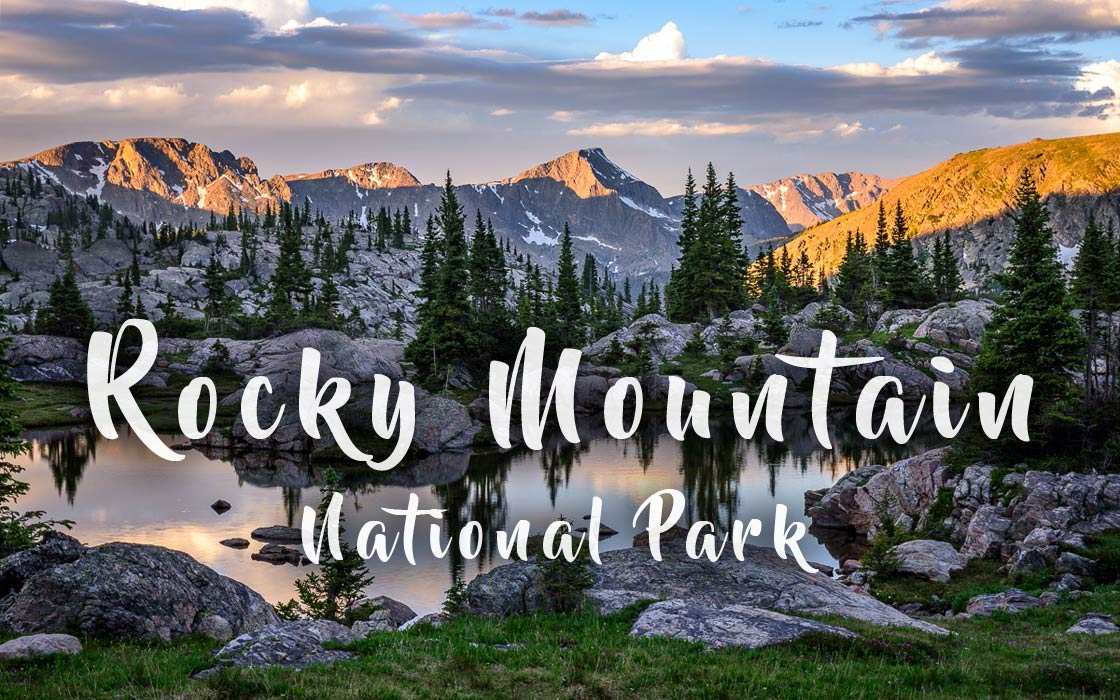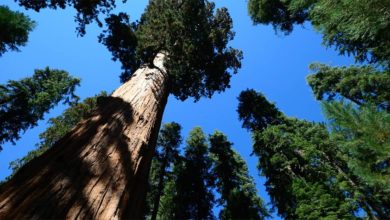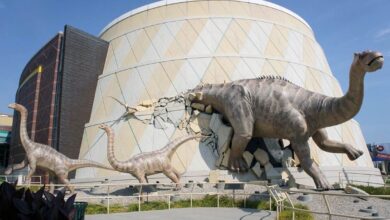Rocky Mountain National Park
Rocky Mountain National Park
Rocky Mountain National Park is a natural wonder located in northern Colorado, USA. Spanning over 265,000 acres, the park is home to towering peaks, pristine lakes, sprawling tundra, and an abundance of wildlife. With over 300 miles of hiking trails, visitors can experience the park’s breathtaking beauty on foot, while scenic drives like Trail Ridge Road offer stunning panoramic views of the surrounding mountains. Whether you’re an experienced hiker or simply seeking a peaceful escape, Rocky Mountain National Park is a must-visit destination that offers something for everyone.
Rocky Mountain National Park is a national park located in the northern Front Range of the Rocky Mountains, in the state of Colorado in the United States. The park encompasses (1,073 square kilometers) 415 square miles and includes several peaks over (3,658 meters) 12,000 feet in elevation, including Longs Peak, which is the highest point in the park at (4,346 meters) 14,259 feet. The park is known for its diverse wildlife, including elk, bighorn sheep, and moose, as well as its hiking trails, scenic drives, and alpine scenery. The park also offers opportunities for camping, fishing, and backpacking. It is one of the most visited national parks in the United States, with around 4.5 million visitors per year.

Location
Rocky Mountain National Park is located in the northern Front Range of the Rocky Mountains in the state of Colorado, in the United States. Specifically, it is located in the counties of Larimer and Grand, and it is about an hour and a half northwest of Denver and about two hours from Colorado’s major airport Denver International Airport (DIA). The Park entrance is on US Hwy 34 on the east side and US Hwy 36 on the north side.

History and name of the park
Rocky Mountain National Park was first established as a national park on January 26, 1915. The park was originally known as the Rocky Mountain National Park Reserve and was re-designated as a national park in 1915. The park was created to protect the diverse wildlife, natural beauty, and ecological significance of the Rocky Mountains in Colorado.
The park’s name, “Rocky Mountain,” refers to the range of mountains that the park encompasses, the Rocky Mountains. The range is named for the many rocky outcroppings that are found throughout the mountains. The Rocky Mountains are a major mountain range in North America, stretching from the far north of British Columbia in Canada to New Mexico in the United States.
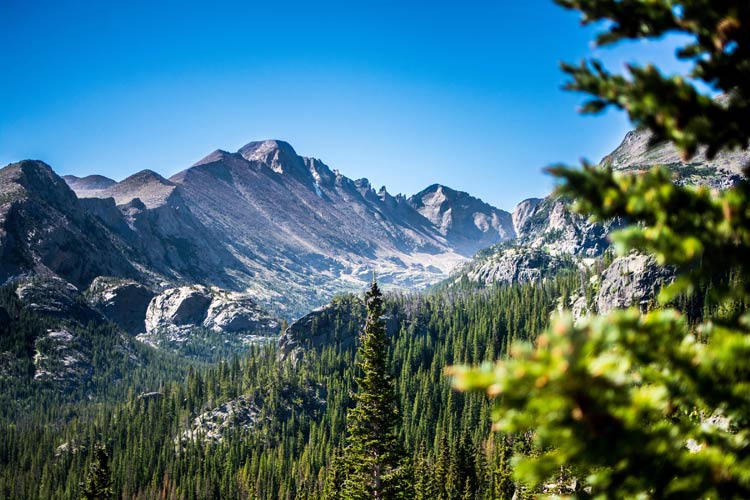
Geography of the Park
Rocky Mountain National Park encompasses 415 square miles (1,073 square kilometers) of rugged alpine terrain in the northern Front Range of the Rocky Mountains in Colorado. The park is home to a diverse array of landscapes and features, including high peaks, alpine tundra, forests, valleys, and rivers.
The park is divided into several distinct regions, including the Front Range, which includes the park’s highest peaks, including Longs Peak (14,259 feet / 4,346 meters), and the Mummy Range, which is a group of peaks that rise over 13,000 feet (4,000 meters) in elevation. The park also includes the Never Summer Mountains, a range of peaks that reach over 12,000 feet (3,658 meters) in elevation, and the Indian Peaks, which are a group of peaks that rise over 13,000 feet (4,000 meters) in elevation.
The park is also home to several rivers and streams, including the Big Thompson River and the Colorado River, as well as several alpine lakes, such as Bear Lake, which is a popular destination for hiking and picnicking. The park also includes several valleys, such as the Kawuneeche Valley, which is a popular destination for hiking and wildlife viewing.
The park also features alpine tundra, which is a unique ecosystem that is characterized by low-growing plants, such as mosses, lichens, and wildflowers, that are adapted to the harsh conditions of high elevations. The alpine tundra is a popular destination for hiking and wildlife viewing, and it is home to a diverse array of animals, including bighorn sheep, elk, and marmots.
Overall, Rocky Mountain National Park offers a unique blend of natural beauty and ecological significance, making it a popular destination for outdoor enthusiasts and nature lovers.

Geology of the Rocky Mountain National Park
The Rocky Mountain National Park is known for its rugged and diverse geology, which has been shaped by millions of years of tectonic activity, erosion, and glaciation.
- Tectonic activity
The park’s geology is dominated by the Front Range of the Rocky Mountains, which were formed by a series of uplifts caused by tectonic activity about 80 million years ago. This activity created a range of mountains that reach elevations of over 14,000 feet, and are composed of ancient Precambrian and Paleozoic rocks. - Erosion
Over time, erosion has shaped the park’s mountains and valleys, carving out deep canyons and creating steep cliffs. The park’s geology is characterized by a wide range of rock types including granite, gneiss, schist, and sandstone. - Glaciation
During the last ice age, glaciers carved out many of the park’s valleys, lakes, and peaks. The glaciers also deposited large amounts of rock and debris, creating moraines, and U-shaped valleys. The glaciers also created many of the park’s lakes, such as Bear Lake, and Dream Lake. - Volcanic activity
There’s some evidence that volcanic activity occurred in the park, including ash falls and volcanic tuffs. - The park’s geology is constantly changing, and visitors can see evidence of this in the form of rockfalls and landslides. The park’s geology also affects the park’s hydrology, with the park’s mountains acting as a barrier to precipitation, creating rain shadows and microclimates.
- The park’s geology also plays an important role in shaping the park’s ecosystems, with different rock types and elevations supporting different plant and animal communities.
The geology of Rocky Mountain National Park is a major attraction for visitors who are interested in geology, geomorphology, and earth science. The park’s rugged landscapes, ancient rocks, and glacial features are a testament to the power of tectonic activity, erosion, and glaciation, and are an integral part of the park’s natural beauty.

The highest peaks in the Park
The highest peaks in Rocky Mountain National Park are:
- Longs Peak: 14,259 feet / 4,346 meters
- Mount Meeker: 13,911 feet / 4,242 meters
- Mount Lady Washington: 13,281 feet / 4,042 meters
- Pagoda Mountain: 13,497 feet / 4,114 meters
- Mount Audubon: 13,223 feet / 4,029 meters
- Mount Toll: 13,153 feet / 4,009 meters
- Chiefs Head Peak: 13,579 feet / 4,140 meters
- Storm Peak: 12,148 feet / 3,710 meters
- Notchtop Mountain: 12,129 feet / 3,703 meters
- Hagues Peak: 13,560 feet / 4,135 meters
These peaks are all over 13,000 feet (4,000 m) in elevation and offer challenging and rewarding hikes for experienced hikers. Longs Peak is one of the most popular peaks to hike, with a challenging trail that leads to the summit. The park also offers a variety of other hiking trails, which provide spectacular views of the surrounding mountains and valleys.

Glaciers, lakes, tundra and rocky peaks in the park
Rocky Mountain National Park is home to several glaciers, lakes, tundra, and rocky peaks.
Glaciers
While there are no glaciers left in Rocky Mountain National Park today, many of the park’s peaks, including Longs Peak, were shaped by glaciers in the past. The park’s high elevations and steep slopes have allowed for the preservation of glacial cirques, which are bowl-shaped valleys created by glaciers.
Lakes
The park is home to over 150 lakes and tarns, many of which are located in the high country, above tree line. Some of the most popular lakes in the park include Bear Lake, Sprague Lake, and Emerald Lake. These lakes are popular destinations for hiking, fishing, and picnicking.
Tundra
The park is home to a large area of alpine tundra, which is a unique ecosystem that is characterized by low-growing plants, such as mosses, lichens, and wildflowers, that are adapted to the harsh conditions of high elevations. The tundra is a popular destination for hiking and wildlife viewing, and it is home to a diverse array of animals, including bighorn sheep, elk, and marmots.
Rocky peaks
The park is home to many rocky peaks, including the park’s highest peak, Longs Peak, as well as Mount Meeker, Mount Lady Washington, and Pagoda Mountain. These peaks are popular destinations for hiking and climbing and offer spectacular views of the surrounding mountains and valleys.
In addition, the park features many rocky outcroppings and cliffs, which offer opportunities for rock climbing, and the park also has a few glaciers that are visible but not accessible.

Climate of Rocky Mountain National Park
The climate of Rocky Mountain National Park is characterized by high elevations and a wide range of temperatures. The park experiences four distinct seasons, with winter bringing heavy snowfall and sub-zero temperatures, while summers are mild with occasional thunderstorms.
- Winter (December to February)
The park receives an average of around 9 feet of snowfall during the winter months, and temperatures can drop well below freezing, with an average low of -9°C (15°F). Many of the park’s roads and facilities are closed during the winter, but visitors can enjoy activities such as cross-country skiing, snowshoeing, and snowmobiling. - Spring (March to May)
The spring months bring warmer temperatures and melting snow, with an average high of around 6°C (42°F) and an average low of -2°C (28°F). The park’s wildflowers begin to bloom, and visitors can enjoy hiking and camping as the weather becomes more favorable. - Summer (June to August)
The park’s summers are mild, with an average high of around 15°C (59°F) and an average low of 6°C (43°F). Thunderstorms are common during the summer months, and visitors can enjoy a wide range of activities such as hiking, fishing, and camping. - Fall (September to November)
The fall months bring cooler temperatures and colorful foliage, with an average high of around 8°C (46°F) and an average low of -1°C (30°F). Visitors can enjoy hiking and wildlife viewing as the park’s elk and other animals prepare for winter.
The park’s climate can be unpredictable and visitors should be prepared for a wide range of temperatures and weather conditions. It’s always advisable to check the weather forecast before visiting, and to bring appropriate clothing and gear for the season and the activities planned.

Rocky Mountains
The Rocky Mountains, also known as the Rockies, are a major mountain range located in western North America. They stretch over 3,000 miles (4,800 kilometers) from British Columbia and Alberta in Canada, through Montana, Wyoming, Colorado, and New Mexico in the United States, to Chihuahua in Mexico. They are a part of the North American Cordillera, which also includes the Pacific Ranges and the Interior Ranges.
The Rockies are known for their rugged beauty and diverse landscapes, which include towering peaks, deep canyons, dense forests, alpine meadows, and rushing rivers. The range is home to a wide variety of plant and animal life, including elk, bighorn sheep, bears, wolves, and many species of birds.
The Rockies are also a major recreational destination, with many national parks and wilderness areas, such as Rocky Mountain National Park, Yellowstone National Park, and Banff National Park, which provide opportunities for hiking, camping, fishing, skiing, and other outdoor activities.
The Rocky Mountains are also rich in mineral resources, including coal, oil, and natural gas, as well as precious metals such as gold and silver. The mountains have also played an important role in the history of North America, serving as a major barrier to westward expansion and as a major source of natural resources.
In terms of geology, the Rocky Mountains are a result of the uplift of the Earth’s crust caused by tectonic forces. They are considered to be a young mountain range and still continue to rise. The range is composed mostly of Precambrian and Paleozoic rocks and overlain with sedimentary rocks, and is home to numerous mineral deposits including coal, oil, natural gas, gold, and silver.

Ecology of the Rocky Mountain National Park
The ecology of Rocky Mountain National Park is diverse and complex, with a wide range of plant and animal communities that are adapted to the park’s diverse geology and climate.
- Elevation
The park’s ecosystems are strongly influenced by elevation, with different plant and animal communities found at different elevations. At lower elevations, visitors can find forests of ponderosa pine, Douglas fir, and Engelmann spruce, while at higher elevations, visitors can find subalpine forests and alpine tundra. - Climate
The park’s ecosystems are also influenced by the park’s climate, with different plant and animal communities found in different parts of the park depending on precipitation, temperature, and exposure to sun and wind. - Flora
The park is home to over 1000 species of plants, including wildflowers, shrubs, and trees. The flora of the park varies depending on the elevation, with species such as Aspen, Douglas fir, Engelmann spruce and subalpine forests at lower elevations, while alpine tundra at higher elevations. - Fauna
The park is home to a wide variety of animals, including elk, bighorn sheep, moose, black bears, mountain lions, and many species of birds, fish and reptiles. The park is also home to many species of small mammals, such as marmots and pikas, that are adapted to the park’s alpine tundra. - Human impact
The park’s ecosystems have been influenced by human activity, including logging, mining, and grazing, which has led to the loss of some plant and animal communities. However, the park’s ecosystems are protected, and visitors are asked to follow park rules to minimize their impact on the environment.
The ecology of Rocky Mountain National Park is a major attraction for visitors who are interested in biology, ecology, and natural history. The park’s diverse ecosystems, unique flora and fauna, and spectacular landscapes are an integral part of the park’s natural beauty, and visitors can learn much about the park’s ecological processes by visiting the park.

Flora in Rocky Mountain National Park
Rocky Mountain National Park is home to a diverse array of plant life, including many species of wildflowers, shrubs, and trees.
The park’s lower elevations are dominated by forests of ponderosa pine, Douglas fir, and Engelmann spruce, while the subalpine and alpine regions are characterized by stands of aspen, subalpine fir, and bristlecone pine.
The park is also home to a wide variety of wildflowers, including lupines, columbines, and Indian paintbrushes, which bloom in the spring and early summer. The alpine tundra is home to unique wildflowers such as alpine forget-me-nots, alpine sunflowers, and alpine shooting stars, which are adapted to the harsh conditions of the high elevations.
In addition, the park also has a number of wetlands, including beaver ponds, which are home to a variety of aquatic plants such as cattails, bulrushes, and sedges.
The park is also home to many species of shrubs, including serviceberry, chokecherry, and currant, which provide food and habitat for a wide variety of wildlife. The park’s meadows are also home to a variety of grasses, including blue grama, needle-and-thread, and western wheatgrass.
Overall, Rocky Mountain National Park has a varied and diverse flora, which is well adapted to the park’s diverse range of elevations, temperatures, and precipitation.
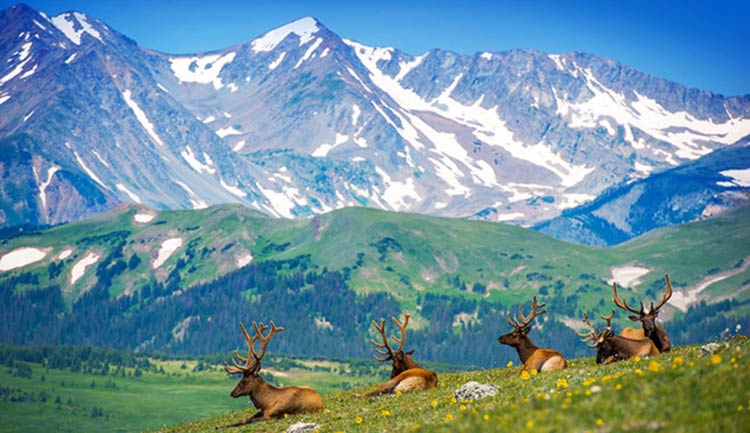
Fauna in Rocky Mountain National Park
Rocky Mountain National Park is home to a wide variety of wildlife, including many species of mammals, birds, fish, and reptiles. Some of the most notable fauna species found in the park include:
- Elk
Elk are one of the park’s most iconic animals and can be seen throughout the park, particularly in the fall during the rutting season. - Moose
Moose are found in the park’s subalpine and alpine regions, where they feed on willows, aspens and other vegetation. - Bighorn sheep
Bighorn sheep can be seen on the park’s rocky cliffs and outcroppings, where they graze on grasses and herbs. - Black bears and grizzly bears
Although grizzly bears are not found in the park, black bears are commonly seen in the park’s forests and meadows, where they feed on berries, nuts, and insects. - Mountain lions
These large cats are found throughout the park, but are elusive and not often seen. - Marmots
Marmots are large ground squirrels that are often seen sunning themselves on rocky outcroppings and talus slopes. - Pika
These small, rabbit-like mammals are found in the park’s alpine regions, where they live among the rocks and talus.
Birds such as the golden eagle, American dipper, and ravens are often seen in the park, along with many species of songbirds such as the mountain bluebird, American robin, and mountain chickadee.
The park also has a number of fish species such as cutthroat trout, brook trout, and rainbow trout that can be found in the park’s streams and rivers. Reptiles such as the garter snake and the painted turtle can also be found in the park, along with a variety of amphibians including the wood frog and the boreal chorus frog.
Overall, Rocky Mountain National Park is home to a diverse and abundant array of wildlife, providing ample opportunities for visitors to see and appreciate the park’s natural heritage.

Region 1: Moose and big meadows
Region 1 of Rocky Mountain National Park is located in the northeastern section of the park and is known for its large, open meadows and its moose population. This region is characterized by its subalpine and alpine forests, which are home to a variety of wildlife, including elk, bighorn sheep, and black bears.
The region’s meadows, such as the Moraine Park and Horseshoe Park, are popular spots for visitors to see wildlife, particularly during the park’s fall elk rutting season. The meadows are also home to a variety of wildflowers and other plants, making them popular destinations for hikers and nature enthusiasts.
Moose are also commonly seen in this region, particularly in the park’s wetlands and along the park’s streams and rivers, where they feed on willows, aspens, and other vegetation. Moose are one of the park’s most iconic animals and are a favorite among visitors.
The region is also home to a number of popular hiking trails, including the Bear Lake Trail and the Fern Lake Trail, which offer visitors the opportunity to explore the park’s subalpine and alpine regions and take in the stunning views of the park’s peaks and valleys.
In addition, the region also has a number of campgrounds and picnic areas, allowing visitors to spend the night and explore the area more fully. Overall, Region 1 of Rocky Mountain National Park offers visitors the opportunity to see a wide variety of wildlife, explore beautiful meadows and forests, and experience the park’s natural beauty.

Region 2: Alpine region
Region 2 of Rocky Mountain National Park is located in the central and southern sections of the park and is known for its high altitude, alpine terrain. The highest peaks in the park, such as Longs Peak (4,346 meters) and Mount Meeker (4,317 meters) are located in this region. This region is characterized by its rugged, rocky terrain, glaciers, and high-altitude tundra, which are home to a variety of wildlife, including bighorn sheep, mountain goats, and pika.
The alpine region is known for its stunning views and is a popular destination for hikers and mountaineers. Some of the park’s most popular hiking trails, such as the Keyhole Route on Longs Peak and the Sky Pond Trail, are located in this region, offering visitors the opportunity to explore the park’s alpine landscapes and take in the views of the surrounding peaks and valleys.
The alpine region is also home to a number of glacial lakes, such as Sky Pond, Alberta Falls, and Mills Lake, which are popular destinations for visitors looking to enjoy the park’s natural beauty. The region is also home to a number of campgrounds and picnic areas, allowing visitors to spend the night and explore the area more fully.
The alpine tundra is a unique ecosystem and is home to a variety of tundra plants such as moss campion, alpine forget-me-not, and alpine goldenrod.
Overall, Region 2 of Rocky Mountain National Park offers visitors the opportunity to experience the park’s alpine landscapes, explore rugged terrain, and see some of the park’s most iconic peaks and glaciers. It also offers the chance to observe the unique flora and fauna of the alpine tundra.

Region 3: Wilderness
Region 3 of Rocky Mountain National Park is located in the western section of the park and is known for its wilderness terrain. This region is characterized by its remote, rugged, and wild landscapes that are home to a variety of wildlife, including elk, black bears, and mountain lions. The region encompasses the Park’s largest wilderness area, the Indian Peaks Wilderness, which offers visitors the opportunity to experience the park’s wilderness landscapes and see some of the park’s most iconic peaks, such as Mount Audubon and Mount Toll.
The region is popular among hikers, backpackers, and wilderness enthusiasts. It offers a variety of hiking trails, such as the Buchanan Pass Trail, the Diamond Lake Trail, and the King Lake Trail, which offer visitors the opportunity to explore the park’s wilderness landscapes and take in the stunning views of the surrounding peaks and valleys. These trails are less crowded and offer a more remote experience.
The region is also home to a number of backcountry campsites and wilderness camps, which allow visitors to spend the night and explore the area more fully. The region’s backcountry areas offer a true wilderness experience and visitors should be well-prepared with the necessary equipment and knowledge to navigate the rugged terrain.
The region is also home to a variety of wildflowers, and the rocky terrain is home to some unique and rare plants, such as the sky pilot, which is a member of the primrose family.
Overall, Region 3 of Rocky Mountain National Park offers visitors the opportunity to experience the park’s wilderness landscapes, explore remote and rugged terrain, and see some of the park’s most iconic peaks and valleys. It also offers the chance to observe the unique flora of the region.

Region 4: Heart of the park
Region 4 of Rocky Mountain National Park is located in the heart of the park and encompasses the park’s most popular and iconic landscapes. This region is characterized by its diverse terrain, including valleys, meadows, and forests, which are home to a variety of wildlife, including elk, moose, and bighorn sheep. The region is a popular destination for visitors looking to experience the park’s natural beauty and see some of the park’s most iconic landscapes.
The region is popular among hikers, campers, and nature enthusiasts. It offers a variety of hiking trails, such as the Bear Lake Trail, the Dream Lake Trail, and the Nymph Lake Trail, which offer visitors the opportunity to explore the park’s diverse landscapes and take in the stunning views of the surrounding peaks and valleys. These trails are popular and offer a more crowded experience.
The region is also home to a number of campgrounds and picnic areas, which allow visitors to spend the night and explore the area more fully. The region’s valleys and meadows offer visitors the chance to see the park’s iconic landscapes such as the Horseshoe Park and Moraine Park.
The region is also home to a variety of wildflowers, and the forested areas are home to a variety of trees such as the lodgepole pine, subalpine fir and Engelmann spruce.
Overall, Region 4 of Rocky Mountain National Park offers visitors the opportunity to experience the park’s diverse landscapes, explore popular trails, and see some of the park’s most iconic peaks, valleys, and meadows. It also offers the chance to observe the unique flora and fauna of the region.

Region 5: Waterfalls and backcountry
Region 5 of Rocky Mountain National Park is located in the eastern section of the park and is known for its waterfalls and backcountry terrain. This region is characterized by its remote, rugged, and wild landscapes that are home to a variety of wildlife, including elk, black bears, and mountain lions. The region encompasses the Park’s backcountry area and offers visitors the opportunity to experience the park’s wilderness landscapes and see some of the park’s most iconic peaks, such as Mount Lady Washington and Pagoda Mountain.
The region is popular among hikers, backpackers, and wilderness enthusiasts. It offers a variety of hiking trails, such as the North Inlet Trail, the Tonahutu Creek Trail, and the Flattop Mountain Trail, which offer visitors the opportunity to explore the park’s wilderness landscapes and take in the stunning views of the surrounding peaks and valleys. These trails are less crowded and offer a more remote experience.
The region is also home to a number of backcountry campsites and wilderness camps, which allow visitors to spend the night and explore the area more fully. The region’s backcountry areas offer a true wilderness experience and visitors should be well-prepared with the necessary equipment and knowledge to navigate the rugged terrain.
The region is also known for its waterfalls, such as the Adams Falls, and the backcountry lakes, such as the Sky Pond, which offers visitors the opportunity to see some of the park’s most beautiful and secluded landscapes.
Overall, Region 5 of Rocky Mountain National Park offers visitors the opportunity to experience the park’s wilderness landscapes, explore remote and rugged terrain, and see some of the park’s most iconic peaks, waterfalls, and backcountry lakes. It also offers the chance to observe the unique flora and fauna of the region.

Wildfires in the Rocky Mountain National Park
Wildfires are a natural part of the ecosystem in the Rocky Mountain National Park, and they play an important role in shaping the park’s landscapes and ecosystems. However, in recent years, the park has seen an increase in the frequency and severity of wildfires due to a combination of factors such as climate change, drought, and human activity.
- Causes of wildfires
Wildfires in the Rocky Mountain National Park are usually caused by lightning strikes, but they can also be caused by human activities such as campfires, cigarettes, and fireworks. Human-caused fires are preventable and can be avoided by following park rules and regulations. - Fire management
The park has a fire management plan in place to protect visitors, park resources, and surrounding communities. This includes monitoring for wildfire activity, conducting prescribed burns, and implementing fire restrictions during periods of high fire danger. - Effects of wildfires
Wildfires can have both positive and negative effects on the park’s ecosystems. On one hand, fires can help clear out dead and dry vegetation, promote new growth, and improve the health of some plant communities. On the other hand, fires can also damage or destroy habitats, harm wildlife, and negatively impact the park’s natural beauty. - Visitors during fire season
During the fire season, the park may have to close some areas or implement fire restrictions to prevent human-caused fires. Visitors are encouraged to check the park’s website and social media for updates on fire activity and closures. They should also be aware of fire danger and take appropriate precautions.
Wildfires are an important part of the Rocky Mountain National Park’s ecosystem, but they can also be destructive. The park’s fire management plan is designed to protect visitors and park resources while also allowing natural fires to play their role in shaping the park’s landscapes.

Attractions for tourists in the park
Rocky Mountain National Park offers a variety of attractions for tourists, including:
- Scenic drives
The park features several scenic drives, such as the Trail Ridge Road, which is the highest paved road in North America and offers breathtaking views of the park’s peaks and valleys. - Hiking
The park offers over 300 miles of hiking trails, which range from easy nature walks to strenuous backcountry treks. Some popular trails include the Bear Lake Trail, the Dream Lake Trail, and the Nymph Lake Trail. - Camping
The park has five front-country campgrounds and several backcountry campsites, which offer visitors the chance to spend the night and explore the park more fully. - Wildlife viewing
The park is home to a wide variety of wildlife, including elk, moose, bighorn sheep, and bison, as well as a diverse range of birds, such as the golden eagle, the American dipper, and the Clark’s nutcracker. - Fishing
The park has several lakes and streams that are stocked with fish, and visitors can obtain a fishing permit to catch brook, cutthroat, and rainbow trout. - Ranger-led programs
The park offers a variety of ranger-led programs, such as guided hikes, campfire talks, and nature walks, which provide visitors with an in-depth look at the park’s natural and cultural history. - Visitor Centers
The park has several visitor centers, such as the Beaver Meadows Visitor Center and the Alpine Visitor Center, which provide visitors with information on the park’s history, geology, and wildlife, as well as exhibits and educational programs. - Winter activities
During the winter, the park offers a variety of winter activities, such as cross-country skiing, snowshoeing, and sledding, as well as guided snowcoach tours and winter ranger-led programs. - Estes Park
Estes Park is a popular tourist destination located just outside the park’s eastern boundary, and it offers a variety of shops, restaurants, and accommodations for visitors. It is also the starting point for many park activities, such as the shuttle buses that take visitors to the park’s trailheads and scenic drives. - Photography
The park is a popular destination for photographers due to its stunning landscapes, diverse wildlife, and colorful wildflowers. Visitors can take advantage of the park’s many scenic viewpoints and hiking trails to capture breathtaking photos of the park’s peaks, valleys, and wildlife. - Rock Climbing
The park offers a variety of options for rock climbing enthusiasts, from beginner to advanced routes. Climbers can explore granite peaks, and enjoy the beautiful views while climbing. - Horseback Riding
Visitors can take guided horseback rides through the park and explore the backcountry on horseback. The guided rides are a great way to see the park’s wildlife and landscapes while enjoying the peacefulness of horseback riding.
Overall, Rocky Mountain National Park offers a wide range of activities and attractions for visitors, including scenic drives, hiking, camping, wildlife viewing, fishing, ranger-led programs, visitor centers, winter activities and much more. It is a great destination for nature lovers, outdoor enthusiasts, and those looking for a peaceful and scenic vacation in the mountains.

Access – Trail Ridge Road and other roads
Trail Ridge Road is one of the most popular roadways in Rocky Mountain National Park and offers visitors an opportunity to experience the park’s high alpine environments. The road is open seasonally, typically from Memorial Day to mid-October, depending on snowpack and weather conditions.
Trail Ridge Road
The road is 48 miles long and reaches an elevation of 12,183 feet at its highest point, making it the highest continuous paved road in the United States. Along the way, visitors can experience stunning views of the park’s peaks, alpine tundra, and valleys. The road also offers access to several popular hiking trails and overlooks.
Other roads
In addition to Trail Ridge Road, there are several other roads in the park that offer access to different regions and attractions. Some of the most popular include:
- Bear Lake Road: a popular road that provides access to the park’s popular Bear Lake area, which offers hiking trails, a scenic lake, and views of the Continental Divide.
- Old Fall River Road: a 9-mile long one-way road that provides access to the park’s high country.
- Grand Lake Entrance: the western entrance to the park, which offers access to the historic town of Grand Lake and the park’s western regions.
Road conditions
Road conditions in the park can vary depending on the season and weather conditions. Visitors are encouraged to check the park’s website or social media for updates on road closures, construction, and other alerts.
Shuttle Services
Rocky Mountain National Park also provides shuttle services for visitors to access the park and reduce the number of cars on the road. During peak season visitors can take the shuttle service from Estes Park to Bear Lake, Moraine Park, and Glacier Gorge, and Hiker Shuttle service to the park’s most popular trailheads.
Trail Ridge Road is one of the most popular and iconic roads in Rocky Mountain National Park, offering visitors an opportunity to experience the park’s high alpine environments. However, there are several other roads in the park that offer access to different regions and attractions. Visitors are advised to check the park’s website or social media for updates on road conditions and closures before their trip, and also take into account alternative options such as shuttle services.
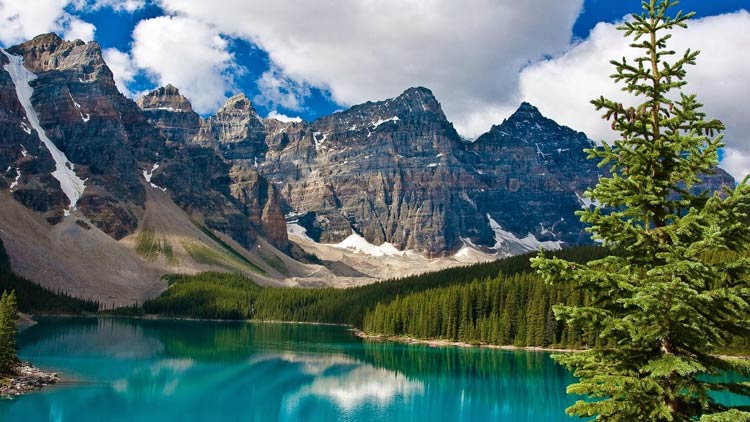
Rocky Mountain National Park – interesting facts
- Rocky Mountain National Park was established on January 26, 1915, and it is the third-oldest national park in the United States.
- The park covers an area of approximately 265,715 acres and it features over 60 peaks that exceed 12,000 feet in elevation.
- The park is home to a wide variety of plant and animal life, including over 60 species of mammals, 280 species of birds, and 900 species of plants.
- The park’s alpine tundra is home to over 700 varieties of wildflowers, and it is one of the most diverse alpine environments in North America.
- The park’s Trail Ridge Road is the highest continuous paved road in the United States, reaching an elevation of 12,183 feet above sea level.
- The park has the largest elk herd in Colorado, and visitors can often see these majestic animals grazing in the park’s meadows during the fall.
- The park has five campgrounds that can accommodate more than 600 campsites, and it also offers backcountry camping for those looking for a more rugged camping experience.
- The park’s highest peak, Longs Peak, is a popular destination for climbers, and it is one of the most challenging 14ers (peaks over 14,000 feet) in the state.
- The park is home to the highest paved road in North America, Trail Ridge Road, and the highest continuous paved road in the United States, reaching an elevation of 12,183 feet above sea level.
- The park has a strong history of preserving its natural and cultural resources, it is home to several historic sites, including old homesteads, mining sites, and ranger stations.

Q&A (questions and answers) about the Rocky Mountain National Park
Q: Where is Rocky Mountain National Park located?
A: Rocky Mountain National Park is located in the northern Front Range of the Rocky Mountains, in the state of Colorado, USA. It is about 65 miles (105 km) northwest of Denver and about 80 miles (129 km) south of the Wyoming border.
Q: What are the highest peaks in the Park?
A: The highest peaks in Rocky Mountain National Park are Longs Peak at 14,259 feet (4,346 m) and Mount Meeker at 13,911 feet (4,242 m).
Q: What kind of flora and fauna can be found in the park?
A: Rocky Mountain National Park is home to a wide variety of flora and fauna. Flora in the park includes subalpine forests, alpine tundra, wildflowers, and over 300 species of lichens. Fauna in the park includes elk, bighorn sheep, black bears, moose, mule deer, and a variety of birds and small mammals.
Q: What are the different regions in the park?
A: Rocky Mountain National Park is divided into five main regions: Moose and Big Meadows, Alpine Region, Wilderness, Heart of the Park, and Waterfalls and Backcountry.
Q: What is the climate of the park like?
A: The climate of Rocky Mountain National Park varies depending on elevation. The lower elevations of the park typically have a subalpine climate, with mild summers and cold winters. The higher elevations of the park, above 11,000 feet (3,353 m) have an alpine climate, with cool summers and very cold winters. The park receives an average of around 30 inches (76 cm) of precipitation per year.
Q: What are some popular attractions for tourists in the park?
A: Some popular attractions for tourists in Rocky Mountain National Park include hiking, camping, wildlife viewing, fishing, and scenic drives. Some specific popular attractions include Trail Ridge Road, Bear Lake, and Longs Peak.
Q: What is the geology of the park like?
A: The geology of Rocky Mountain National Park is characterized by the ancient Precambrian rock formations that make up the majority of the park. The park also contains various rock types such as granite, gneiss, and schist, which were formed during the Laramide orogeny.
Q: What is the ecology of the park like?
A: The ecology of Rocky Mountain National Park is characterized by its diverse range of habitats and ecosystems, including subalpine forests, alpine tundra, and high-altitude wetlands. These habitats are home to a wide variety of plant and animal species, including several that are unique to the park.
Q: Are there any wildfires in the park?
A: Wildfires do occur in Rocky Mountain National Park, as they do in many western US national parks. The park has a fire management plan in place to minimize the risk of wildfire and to protect the park’s natural resources. Visitors are advised to check the park’s website or social media for updates on any current fires or fire restrictions before their trip.


